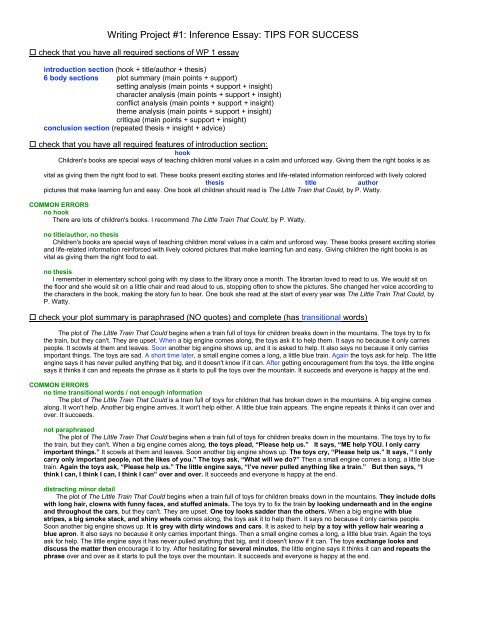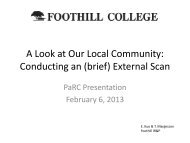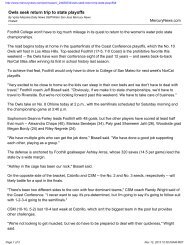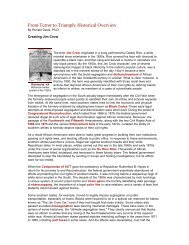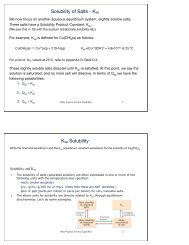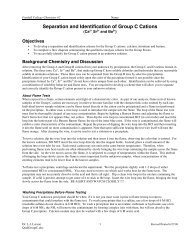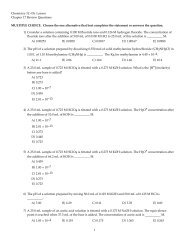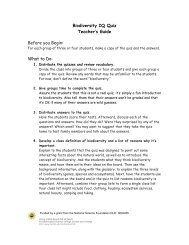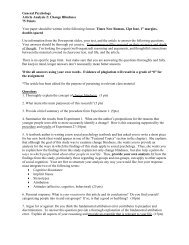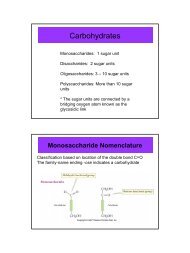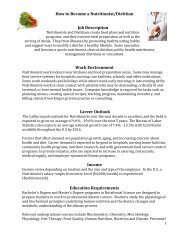Writing Project #1: Inference Essay: TIPS FOR SUCCESS
Writing Project #1: Inference Essay: TIPS FOR SUCCESS
Writing Project #1: Inference Essay: TIPS FOR SUCCESS
Create successful ePaper yourself
Turn your PDF publications into a flip-book with our unique Google optimized e-Paper software.
<strong>Writing</strong> <strong>Project</strong> <strong>#1</strong>: <strong>Inference</strong> <strong>Essay</strong>: <strong>TIPS</strong> <strong>FOR</strong> <strong>SUCCESS</strong><br />
� check that you have all required sections of WP 1 essay<br />
introduction section (hook + title/author + thesis)<br />
6 body sections plot summary (main points + support)<br />
setting analysis (main points + support + insight)<br />
character analysis (main points + support + insight)<br />
conflict analysis (main points + support + insight)<br />
theme analysis (main points + support + insight)<br />
critique (main points + support + insight)<br />
conclusion section (repeated thesis + insight + advice)<br />
� check that you have all required features of introduction section:<br />
hook<br />
Children's books are special ways of teaching children moral values in a calm and unforced way. Giving them the right books is as<br />
vital as giving them the right food to eat. These books present exciting stories and life-related information reinforced with lively colored<br />
thesis title author<br />
pictures that make learning fun and easy. One book all children should read is The Little Train that Could, by P. Watty.<br />
COMMON ERRORS<br />
no hook<br />
There are lots of children's books. I recommend The Little Train That Could, by P. Watty.<br />
no title/author, no thesis<br />
Children's books are special ways of teaching children moral values in a calm and unforced way. These books present exciting stories<br />
and life-related information reinforced with lively colored pictures that make learning fun and easy. Giving children the right books is as<br />
vital as giving them the right food to eat.<br />
no thesis<br />
I remember in elementary school going with my class to the library once a month. The librarian loved to read to us. We would sit on<br />
the floor and she would sit on a little chair and read aloud to us, stopping often to show the pictures. She changed her voice according to<br />
the characters in the book, making the story fun to hear. One book she read at the start of every year was The Little Train That Could, by<br />
P. Watty.<br />
� check your plot summary is paraphrased (NO quotes) and complete (has transitional words)<br />
The plot of The Little Train That Could begins when a train full of toys for children breaks down in the mountains. The toys try to fix<br />
the train, but they can't. They are upset. When a big engine comes along, the toys ask it to help them. It says no because it only carries<br />
people. It scowls at them and leaves. Soon another big engine shows up, and it is asked to help. It also says no because it only carries<br />
important things. The toys are sad. A short time later, a small engine comes a long, a little blue train. Again the toys ask for help. The little<br />
engine says it has never pulled anything that big, and it doesn't know if it can. After getting encouragement from the toys, the little engine<br />
says it thinks it can and repeats the phrase as it starts to pull the toys over the mountain. It succeeds and everyone is happy at the end.<br />
COMMON ERRORS<br />
no time transitional words / not enough information<br />
The plot of The Little Train That Could is a train full of toys for children that has broken down in the mountains. A big engine comes<br />
along. It won't help. Another big engine arrives. It won't help either. A little blue train appears. The engine repeats it thinks it can over and<br />
over. It succeeds.<br />
not paraphrased<br />
The plot of The Little Train That Could begins when a train full of toys for children breaks down in the mountains. The toys try to fix<br />
the train, but they can't. When a big engine comes along, the toys plead, “Please help us.” It says, “ME help YOU. I only carry<br />
important things.” It scowls at them and leaves. Soon another big engine shows up. The toys cry, “Please help us.” It says, “ I only<br />
carry only important people, not the likes of you.” The toys ask, “What will we do?” Then a small engine comes a long, a little blue<br />
train. Again the toys ask, “Please help us.” The little engine says, “I’ve never pulled anything like a train.” But then says, “I<br />
think I can, I think I can, I think I can” over and over. It succeeds and everyone is happy at the end.<br />
distracting minor detail<br />
The plot of The Little Train That Could begins when a train full of toys for children breaks down in the mountains. They include dolls<br />
with long hair, clowns with funny faces, and stuffed animals. The toys try to fix the train by looking underneath and in the engine<br />
and throughout the cars, but they can't. They are upset. One toy looks sadder than the others. When a big engine with blue<br />
stripes, a big smoke stack, and shiny wheels comes along, the toys ask it to help them. It says no because it only carries people.<br />
Soon another big engine shows up. It is grey with dirty windows and cars. It is asked to help by a toy with yellow hair wearing a<br />
blue apron. It also says no because it only carries important things. Then a small engine comes a long, a little blue train. Again the toys<br />
ask for help. The little engine says it has never pulled anything that big, and it doesn't know if it can. The toys exchange looks and<br />
discuss the matter then encourage it to try. After hesitating for several minutes, the little engine says it thinks it can and repeats the<br />
phrase over and over as it starts to pull the toys over the mountain. It succeeds and everyone is happy at the end.
� check setting section is complete<br />
inference text support<br />
The setting takes place in the mountains. There are pictures of hills and mountain tops, and several characters refer to "getting over<br />
explanation of "universal"<br />
the mountains." The location could be any mountains anywhere, and no particular time is mentioned or signaled. This kind of<br />
"universal" setting is used by authors so that the themes make sense to all children throughout time.<br />
COMMON ERRORS<br />
no text support<br />
The setting takes place in the mountains. It's a "universal" setting so the themes make sense to children anywhere.<br />
no mention/explanation of “universal”<br />
The setting takes place in the mountains. There are pictures of hills and mountain tops, and several characters refer to "getting over<br />
the mountains.”<br />
� check character section is complete<br />
transitional sentence text support<br />
There are three main characters. The toys from the broken train can't get over the mountain and they don't know what to do. They<br />
character 1 inference<br />
say, "please help us..." several times in the story. They together represent helplessness or victims, people who can’t fix their problems or<br />
insight text support<br />
improve a bad situation without help. Any child will relate to needing help so will recognize this quality. The two big engines that came<br />
character 2 inference more text support<br />
along wouldn't help the toys. They are used to portray rudeness. One of these trains says, "ME help the likes of YOU? I carry only<br />
important people." The arrogance clearly shows in the author’s emphasis on certain words. The last character is the little blue train. The<br />
text support character 3 inference<br />
pictures of its face show doubt. It says that because it has never pulled a train before, it doesn't think it can. It represents insecurity.<br />
COMMON ERRORS<br />
no/weak text support for inference<br />
There are three main characters. The toys together represent helplessness or victims. Any child will relate to needing help so will<br />
recognize this quality. The two big engines that came along wouldn't help the toys. They are used to portray rudeness. The last character<br />
is the little blue train. It represents feeling too small or insecure.<br />
unsupportable/unclear inference<br />
The two engines that came along are used to portray authority. They won’t help the toys.<br />
� check conflict section is complete<br />
transitional sentence/inference text support<br />
The conflict of this story is insecurity, especially when faced with a difficult task. This conflict is seen when the little blue train is asked to<br />
help the toys by pulling them over the mountain. It looks worried in the pictures and says it’s never done anything like that before. Most<br />
insight<br />
children, and adults, get into this situation. They want to do something challenging but feel unsure.<br />
COMMON ERRORS<br />
weak support<br />
The conflict of this story is dealing with a difficult task. The little blue train has never done anything as hard as that. All children feel<br />
unsure and afraid at times when trying to do things.<br />
plot detail (no inference)<br />
The conflict of this story is trains breaking down in the mountains and the passengers being stranded. This happens a lot.<br />
� check theme section is complete<br />
transitional sentence inference-theme 1<br />
There are four themes in this story. Children learn not to expect everyone to offer help. In fact, the story shows that people can be<br />
text support insight<br />
mean for no reason. Both of the two big engines are rude and leave without helping or offering to get help. Children tend to believe that<br />
inference- theme 2<br />
strangers will be nice. Unfortunately today, we know this isn't true, so this lesson is very important. But conversely, the story teaches that<br />
text support<br />
we do need help from others. The toys couldn't fix their problem on their own. They ask for help throughout the story. And the little engine<br />
insight<br />
needed encouragement from the toys to overcome its doubt. Though we like to think we can do things alone, in reality other people help<br />
inference- theme 3<br />
us all the time, whether directly with physical action or indirectly with support. The most recognized theme of The Little Train is to take<br />
text support<br />
risks even if unsure of your ability. This simple message will be clear to children from the pictures and words of the little engine. After<br />
inference- theme 4<br />
looking worried and saying, "I've never done this before," it starts to try to help. My favorite theme is one often missed: when facing a big<br />
text support<br />
problem, be positive. Near the end of the story, the little train repeats the phrase "I think I can,” words that clearly foster a good attitude. If<br />
insight<br />
you approach a task with positive feelings, you are more likely to succeed.
COMMON ERRORS<br />
no text support<br />
There are three themes in this story. Children, who usually think strangers will be nice, learn not to expect everyone one to offer<br />
help. The most recognized theme of The Little Train That Could is to take risks. Another theme is that when faced with a difficult task, be<br />
positive. My experiences in such situations are that attitude matters most. Children and adults frequently approach a task with negative<br />
feelings and these can prevent success.<br />
incomplete<br />
The theme in this story is to try difficult things. The little engine shows this theme.<br />
� check critique section is complete (all elements are evaluated and opinions are supported):<br />
This story is well crafted, and it has colorful, expressive pictures. It uses easy words so children will understand the ideas. The plot<br />
is simple to follow and the setting is easy to recognize. All children know about mountains, trains, and things breaking down. The<br />
characters will be clear to children because the pictures of them and their words show their feelings. The two big trains look mean and<br />
say rude things. The little train looks worried and expresses doubt. What I would change is to add more description and dialog about how<br />
insecure the little train felt. For example, if one of the toys expressed how worried it felt about new challenges, children would get a<br />
stronger message that others often feel uncertain.<br />
The conflict is relevant. Most people relate to feeling insecure and being the "little kid on the block." The themes are important.<br />
Children may be surprised that the two big trains won't help. If so, parents can teach this lesson on the spot. And having a positive<br />
attitude is applicable to any age. It's great to read a story that talks about fear. Our society says "don't be a baby, grow up" too often.<br />
Children and adults need to know feeling insecure and needing help is common.<br />
COMMON ERRORS<br />
no/unclear text support for opinions / flaws not explained<br />
This story is well written. The plot, setting, conflict, and characters are good. It uses few words so children will understand. All<br />
children will relate to feeling unsure and being the "little kid on the block." It does have a couple of flaws and things I would change<br />
� check conclusion section is complete<br />
repeated thesis<br />
The Little Train That Could is a good children's book because of its valuable themes. And I like the story because of how simple it is<br />
insights<br />
while teaching serious lessons. I often felt afraid to do physical things because I was the smallest kid. I should have read this story again<br />
in grade school. I now realize most children's books offer practical, helpful lessons, and, even those that don't are valuable teaching<br />
advice<br />
tools. Older children should read and discuss these stories to relearn the important lessons or have fun updating their favorite books.<br />
COMMON ERRORS<br />
not much insight / no advice<br />
All in all, The Little Train That Could is a good children's book. I particularly like how simple it is while teaching adult lessons. Telling<br />
children to believe in themselves is great for any age.


